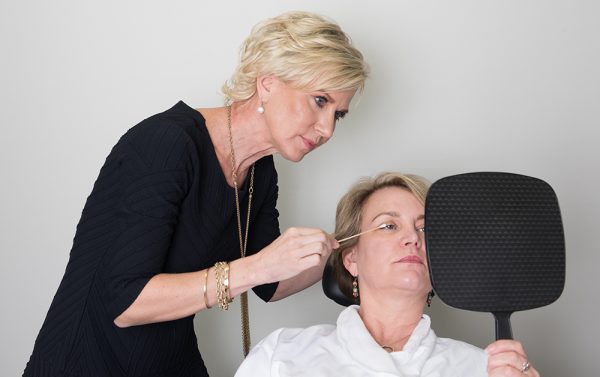What is Blepharoplasty?
At The Plastic Surgery Center of Nashville in Tennessee, we offer eyelid surgery to remove fat, excess skin, and muscle from the upper and lower eyelids. A blepharoplasty can correct drooping eyelids and puffy bags under the eyes, providing a youthful and rejuvenated appearance. Surgery is sometimes combined with a forehead lift to correct sagging eyebrows or laser resurfacing to reduce crow’s feet and other wrinkles around the eyes. Botox® Cosmetic injections and chemical peels are also excellent adjuncts to this procedure.
Blepharoplasty | Eyelid Surgery
Eyelid surgery usually takes one to two hours and is performed under local or general anesthesia. During blepharoplasty, the surgeon makes incisions that follow the natural contours of your eyelids, including the lower area and the creases of your upper lids. These discreetly placed incisions may also extend to the outer corners of your eyes, to treat laugh lines or crow’s feet. The surgeon uses these incisions to remove excess muscle, fat, and skin tissue before closing the incisions with sutures.

After Blepharoplasty | Eyelid Surgery
After you visit our office in Nashville, Tennessee for eyelid surgery, your eyes will likely require ointment for lubrication. You may experience swelling or a tightening sensation as the anesthesia wears off, but most blepharoplasty patients are surprised at how little discomfort they feel.
You should keep your head elevated for a few days after eyelid surgery. Bruising or swelling is most pronounced during the first week of recovery. You can use a cold compress to reduce these conditions. The bruising and swelling generally fade the following week.
Stitches will be removed five to six days after you visit our Nashville, Tennessee office for blepharoplasty. Once the stitches are removed, the discoloration and swelling around the eyes will gradually disappear. You may wear makeup 48 hours after stitches are removed.
Meet the Doctors
Learn about our Board-Certified plastic surgeons and why you should choose two RealSelf 500 award winners for your next procedure!
Meet the Doctors
Learn about our Board-Certified plastic surgeons and why you should choose two RealSelf 500 award winners for your next procedure!
Recovery
Most of the patients at our Nashville, Tennessee office who undergo blepharoplasty begin to feel better after three or four days and can return to work in a week to 10 days. Normally, at this point, makeup can be used to hide any remaining bruising. Eye drops are administered for patients who experience dry or itchy eyes after surgery. You should wear sunglasses as much as possible to avoid various irritants and to protect your sensitive eyes from sunlight. In many cases, patients won’t be able to wear contact lenses for roughly two weeks or longer following surgery.
You should avoid strenuous activity or activities that raise your blood pressure for two to three weeks after eyelid surgery. Post-surgical scars may remain pink for three to six months after treatment. These scars should fade eventually, becoming fine white lines that are barely visible.
Potential Risks
Complications from eyelid surgery are rare and usually minor. Nevertheless, as with any surgery, there is some degree of risk, including possible infection or a negative reaction to the anesthesia. Possible complications following blepharoplasty include temporary swelling, blurred vision, and a slight asymmetry in healing or scarring. Additionally, small whiteheads may appear after your stitches have been removed, but these whiteheads can be easily dealt with. After surgery, some patients may find it difficult to close their eyes during sleep. In very rare cases this condition may become permanent. Another extremely rare post-surgical complication is called ectropion, which describes a pulling down of the lower eyelids. If this should occur, temporary taping of the corners of the eyes or further eyelid surgery may be required.
Blepharoplasty FAQs
The cost of your eyelid surgery in Nashville, TN depends upon multiple factors, including the type of blepharoplasty being performed for your upper or lower eyelids. After your initial consultation, our team at The Plastic Surgery Center of Nashville will provide you with a detailed outline of costs for your eyelid surgery.
You can combine various procedures with blepharoplasty. A forehead lift is often performed in conjunction with eyelid surgery to rejuvenate the appearance of the upper face. You may also get Botox® cosmetic injections or laser resurfacing treatments to treat concerns such as crow’s feet around the eyes for an overall refreshed appearance.
Similar to other surgical procedures, eyelid surgery may cause mild to moderate pain around the surgical site for a few days. But you can effectively manage this pain through medications that are prescribed to you by your plastic surgeon and medical team. With that being said, you will not feel any pain during the surgery itself due to the use of local or general anesthesia.
During the first few weeks after your blepharoplasty, bruising, swelling, and redness may disguise the full extent of your results. These side effects start subsiding in the second week of your surgery, at which point you can see how eyelid surgery has improved the appearance of your eyes. It may take a few months for you to see the full extent of results from your blepharoplasty.
The post-operative swelling, bruising, and redness that appears after blepharoplasty typically dissipates within 1 to 2 weeks. You may go back to work and resume your social activities typically within 7 to 10 days after your eyelid surgery. Some bruising and redness may still be present around your eyes at this point. You can conceal it with the use of makeup.
You may apply makeup to your eyes typically a week after your blepharoplasty. By this time, your stitches will have been removed, and you will have gone through the appropriate recovery period to wear makeup.
Eyelid surgery typically delivers permanent results. While you can still see the effects of aging over time, your blepharoplasty results may last for a lifetime. However, this timeline depends upon various factors like genetics, environmental conditions, and your body’s response to your eyelid surgery. For some patients, the period of blepharoplasty results may last for 10 to 15 years.
You can typically recover from side effects, such as bruising, swelling, and redness, around your eyes in 7 to 10 days following your blepharoplasty. At this time, you can also resume work and light activities. You can also typically get back to strenuous exercise around 2 to 3 weeks following surgery.
Blepharoplasty has a high safety profile and does not cause significant risks to your wellbeing when performed by a qualified plastic surgeon. But some minor chances for complications are still present. These include a possibility for infection and a restriction of movement around your eyes that may need further surgical intervention.
Yes, in cases where sagging eyelid skin impairs vision, blepharoplasty can address this issue by removing excess skin and improving the field of vision.
While there’s no specific age limit, candidates for blepharoplasty are typically adults with signs of aging around the eyes. A consultation with one of our board-certified plastic surgeons will determine if you’re a suitable candidate.
Patients with dry eyes can still undergo blepharoplasty, but it’s crucial to inform your surgeon about any pre-existing conditions. Special considerations may be made to minimize potential dry eye symptoms post-surgery.
Incisions are strategically placed within natural eyelid creases, minimizing the visibility of scars. With proper care, scars typically fade over time and become inconspicuous.
Patients may need to avoid wearing contact lenses for a brief period after surgery. Your surgeon will provide guidance on when it’s safe to resume wearing contacts.
Like any surgical procedure, blepharoplasty carries potential risks, including infection, bleeding, and adverse reactions to anesthesia. These risks will be thoroughly discussed during your consultation.
Depending on the extent of the procedure and patient preference, blepharoplasty can be performed under local anesthesia or general anesthesia. Your board-certified plastic surgeon will discuss the options during the consultation.
Upper eyelid surgery focuses on addressing sagging skin and excess fat on the upper eyelids, while lower eyelid surgery targets bags and puffiness beneath the eyes. Both procedures can be performed together or separately.
In most cases, blepharoplasty is considered a cosmetic procedure and not covered by insurance. However, if the surgery is performed to address a medical issue such as impaired vision, insurance coverage may be possible.
It’s advisable to arrange for transportation on the day of surgery, as the effects of anesthesia and the initial recovery period may make driving unsafe. A responsible adult should accompany you or be available for transportation.
Schedule a Consultation
Ready to book your procedure with one of our board-certified plastic surgeons? Contact us today to schedule your consultation and begin your aesthetic journey!
